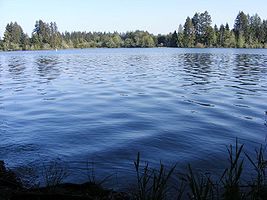
Millersylvania State Park
Encyclopedia

Olympia, Washington
Olympia is the capital city of the U.S. state of Washington and the county seat of Thurston County. It was incorporated on January 28, 1859. The population was 46,478 at the 2010 census...
. The park has 6 miles (9.7 km) of trails (including the 1 miles (1.6 km) fitness trail), old-growth cedar and fir trees, and also features camping and 3,300 feet (1 km) of freshwater shoreline on Deep Lake.
Deep Lake is located in Section 3, Township 16N, Range 2W, Willamette.
According to the survey done by the State Department of Game in 1947, Deep Lake is 17 feet (5.2 m) deep at its deepest part. It covers an area of 66.2 acres (267,902.1 m²), and has a water volume of 771 acre.ft. It was once reportedly home to a rare species of freshwater crab
Freshwater crab
There are around 1,300 species of freshwater crabs, distributed throughout the tropics and subtropics, divided among eight families. They show direct development and maternal care of a small number of offspring, in contrast to marine crabs which release thousands of planktonic larvae. This limits...
as reported in the Miller Family diaries, which went extinct due to overfishing by new settlers coming from the east.
An 1855 survey noted the name as Deep Lake. For a period of time, the lake was called Drake Lake, which was named after the Lyman Darrow Drake Family that settled on the south side of the lake in 1872. The Drake family sold their property in 1908 but the Drake Lake name was still commonly used up until the late 1920s as was evidenced by several US Geological Survey and Metsker Maps dated up to 1929.
History
The first known name of the lake was Deep Lake as noted in a land survey in 1855. For a period of time, the lake went under the name Drake Lake, but was changed back to Deep Lake in 1907.The park was originally called "Miller's Glade" by the Miller family, who once owned the property. The family later changed the name to "Millersylvania," meaning "wooded glade." The park's 842 acres were homesteaded by Squire Lathum in 1855 before being sold to John Miller. Miller's family gave the property to the state in 1921, stipulating that the land must forever be used as a park.
Millersylvania's buildings were reconstructed in 1935 almost entirely by hand by the Civilian Conservation Corps
Civilian Conservation Corps
The Civilian Conservation Corps was a public work relief program that operated from 1933 to 1942 in the United States for unemployed, unmarried men from relief families, ages 18–25. A part of the New Deal of President Franklin D...
. Relics of a narrow-gauge railroad and several skid roads used in the 19th century by the logging industry remain on park grounds. Stumps of trees still carry notch scars where springboards supported brawny loggers.

